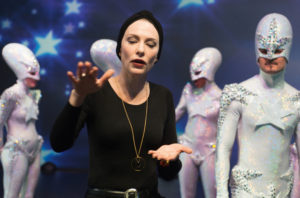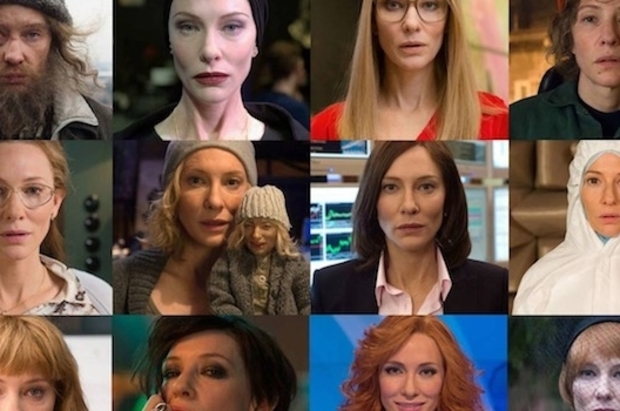CLARISSA SIU reviews Julian Rosefeldt and Cate Blanchett’s high concept film which treads the line between cinema and video art installation.
A two-time Academy Award winner, Blanchett’s talent and versatility have never been doubted in the twenty years of her acting career. She has starred in in major Hollywood productions (Blue Jasmine, Carol), independent projects (Jim Jarmusch’s Coffee and Cigarettes), and franchise films (Thor: Ragnarok, How To Train Your Dragon). Blanchett brings this vitality to her performance in Manifesto as she slips in and out of an ensemble of thirteen different characters. In order of appearance, she plays a homeless man, a broker, a worker at a garbage incineration plant, a CEO, a punk, a scientist, a funeral speaker, a puppeteer, a conservative mother, a choreographer, a newsreader, a reporter, and a schoolteacher. Each time, she does not merely embody; she becomes, and perfectly captures the unique quirks and eccentricities of the characters she plays.
Manifesto is as aptly named as projects come. The brainchild of German video artist Julian Rosefeldt, who wrote, directed, and produced the film, it is a compilation of fragments from fifty-five manifestos published throughout the nineteenth and twentieth centuries. He includes the Manifesto of the Communist Party by Karl Marx and Friedrich Engels (1848), the Dada Manifesto by Tristan Tzara (1918), and the Manifesto of Surrealism by André Breton (1924), to name a few. Blanchett and Rosefeldt met in 2010 at one of his exhibitions in Berlin, and decided to embark upon this project together.
Manifesto is an exploration of political and cultural tropes in art and society. Rosefeldt’s use of intertextuality provides a fascinating glance at how the manifestos manage to complement and conflict with one another. Reflecting the politically uneasy global climate, Manifesto seeks to ‘question the role of the artist in society,’ in the 21st century, as Rosefeldt put it in a 2016 interview with the Australian Centre for the Moving Image. Blanchett recites lines from the various manifestos to visuals of contemporary, everyday situations and locations – at home, in an office, on the streets, and inside a classroom.

Rosefeldt had always envisioned Blanchett in all thirteen roles. It is glaringly obvious that the manifestos included in the film are overwhelmingly by men; this makes the decision to place a woman at the centre of the project all the more significant. Rosefeldt explained he was eager to utilise Blanchett’s ‘very strong feminist energy’ (Vogue) to assign new meaning to the old, masculine texts, which Blanchett herself described as giving them ‘a freshness’ and ‘a new relevance’. She also mentioned that ‘as a woman working in cinema and in the theatre, [she is] well-versed in speaking the words of men’. To her, this project symbolised ‘an act of political response’: a reclamation of power.
In the weeks leading up to filming and production, the duo met regularly to experiment with different texts and ways to perform them. Blanchett then travelled to Berlin in December in 2014, and shot the whole sequence in an impressively compact two weeks.
Despite its premiere at the London Film Festival a week ago, Manifesto can only loosely be called a film. Originally set up as a multi-screen digital installation, with each segment about ten minutes long, it received its European and North American premieres in Berlin and New York respectively. When later asked to compile the visuals into a feature-length film, Rosefeldt felt a certain pressure – there was no real narrative to link the different stories together. The risk, however, paid off. Though the scenes are rearranged and interwoven together, they did not feel out of sync, and each scenario flowed into the next with ease. Though the prospect of sitting through a 90-minute film listening to dialogue that sounds like a Philosophy lecture may be daunting to some, Manifesto is anything but dull. Rosefeldt is well aware of that risk, and counteracts it by including a touch of humour in his film.

As Blanchett plays a conservative mother at the dinner table, dedicated fans may realise that around the table sits her real-life family: her husband Andrew Upton and her three sons, Ignatius, Roman, and Dashiell. Everyone bows their heads for a prayer, and Blanchett, with a cardigan wrapped around her shoulders, starts reciting Claes Oldenburg’s ‘I Am for an Art’ (1961). It was written as a satirical ode to the New Realism movement founded in the 60s, which encouraged the possibility of art created from anything in the artist’s surroundings. ‘I am for Kool art,’ Blanchett recites in a distinguished Southern accent, ‘7UP art, Pepsi art, Sunshine art, pork art, chicken art, tomato art, cake art, cookie art…’ Her family fidgets impatiently, but she remains composed: ‘I am for US Government Inspected Art, Grade A art, Regular Price art, Fully Cleaned art…’ At the film premiere, the audience could not help but snicker in amusement.
The film closes with a collage of Blanchett’s personas staring directly into the camera, breaking the fourth wall as she begins to sing lines from different manifestos. The choir of voices, jumbled up, harmonising whilst simultaneously creating conflict, offers the viewers a final statement on the undulating similarities and differences between the manifestos, and on the importance of different (potentially conflicting) points of view.
Despite the curiosity expressed by the press, Rosefeldt is reluctant to assign a personal aspect to his work. He believes the value of his project comes from the lack of fixed meaning, and prefers to let viewers keep their own interpretations. What he likes best, he says, is the ‘possibility in each of the scenes’. Each viewer is encouraged to ‘find [their] position within this architecture of thought’.
Rosefeldt’s grand ambition complements Blanchett’s electrically charged delivery. Manifesto does not capture our attention – it demands it. It attracts and dominates, and stays with the audience long after the experience is over.
‘Manifesto’ was shown as part of the London Film Festival on the 6th and 8th October and is now on limited release. More information available here.
Individual clips are available to view on Rosefeldt’s website.
Featured image courtesy of film-book.com





